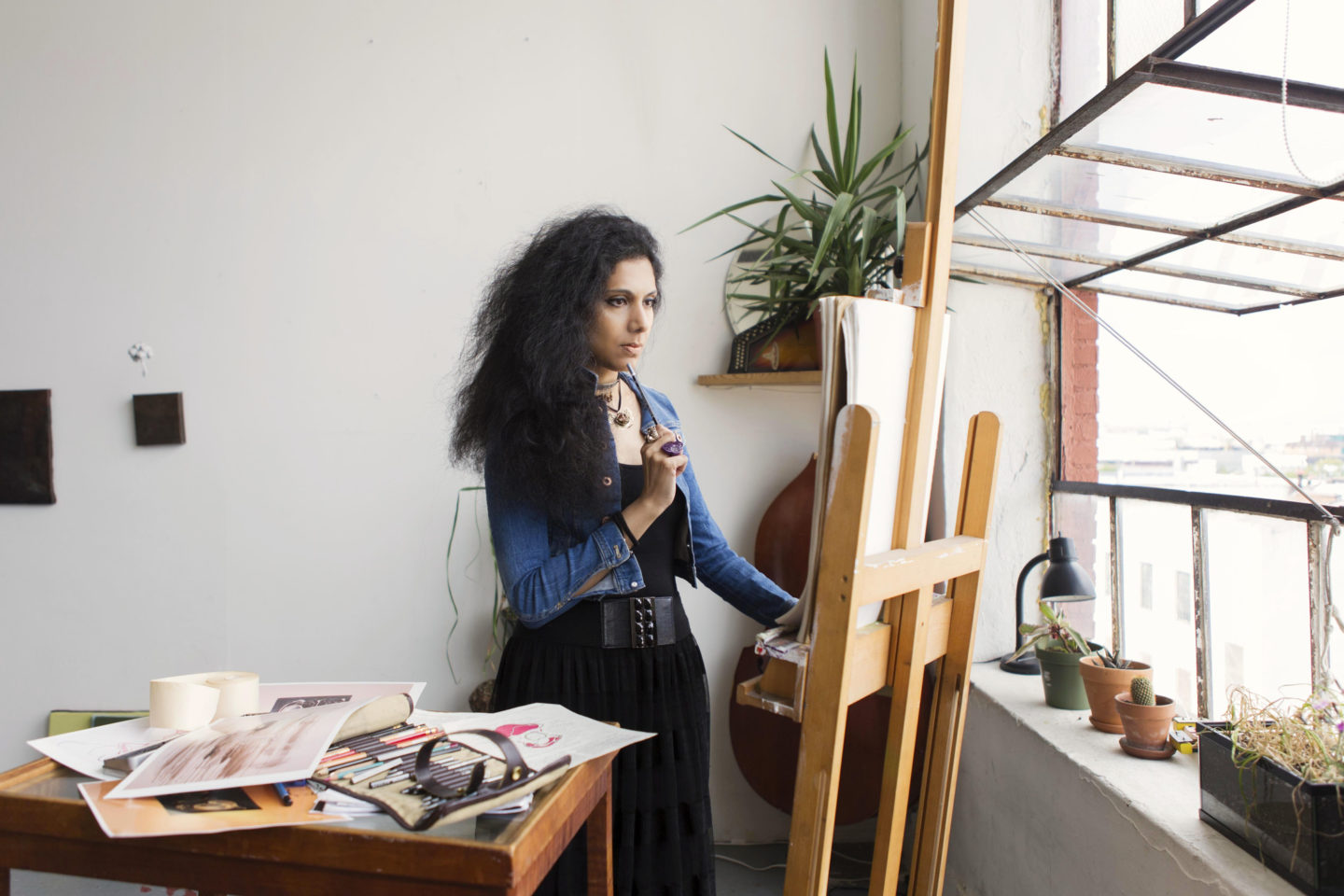Art has long been used to reduce the stigma of periods.
In 2015, poet Rupi Kaur posted a photo on Instagram of her sleeping, lying on her side with her back to the camera. Taken by her sister Prabh, the photo shows blood stains on the back of Kaur’s pants and the bedsheets below. The period stains are dark and surrounded by light colored sweatpants and sheets, forcing you to look at them. Within a day, Instagram removed it, claiming it violated community guidelines. So Kaur posted it again, only to have it removed once again. After a new post detailing what happened to her photos gained 53,000 likes and more than 12,000 shares across social media, Instagram backtracked, claiming it was a “mistake” and an “accident.”
When asked about the photo, Kaur says she “wasn’t being provocative” and was instead trying to “demystify” the stigma of menstruation. Although Instagram eventually let her repost the image to her account, the initial censorship of such an innocuous photo was, ultimately, “the exact response [Kaur’s] work was created to critique.”
This sort of response to menstruation, that it shouldn’t be seen or talked about, is far from new. Historically, not much was written about menstruation. Most scribes in ancient civilizations were cis men who likely didn’t feel that periods were worth being a part of the written record. “Ignorance” and “fear” were also responses to it and, due to the patriarchal history of most cultures. According to Helen King, Professor of Classical Studies at Open University, we don’t even “know whether women’s attitude [about menstruation] was the same [as men’s] or not.”
Menstruation mystified many ancient cultures to the point that it was believed to be mystical. In ancient Egypt, periods were thought to be sorcery and thus the blood was used in both rituals and medicine. The Greeks used menstrual blood combined with wine to their crops more fertile, Roman philosopher Pliny the Elder thought if a menstruating woman was nude, she could prevent thunderstorms and protect crops, and Mayan thought menstruation originated as a punishment after a woman anger the Moon Goddess. Many similar themes and mythologies surrounding menstruation spanned, not only different cultures, but also different continents. Menstruation as a punishment against women for wrongdoing and the need to quarantine menstruating people are prime examples of this that continue to this day. Another interesting example is menstrual synchrony, the belief that periods will sync up to one another and are in sync with certain rhythms of the world, like the moon.
Similar to the lack of written record surrounding menstruation, there is also a lack of ancient art on it as well. This can also likely be attributed in most cultures to cis men being the artists, the ones who got to deem what was important enough to remember. There are a few instances of art involving menstruation, including Nazca pottery that is on display at the National Museum of the Archaeology, Anthropology, and History of Peru, Aboriginal rock carvings found at the Upper Yule River in Western Australia, and ancient Yombe statues used to help regulate menstruation.
The phenomenon of menstrual art didn’t really begin until the 1970s during second-wave feminism. Nearly a 100 years of great strides had been made in menstrual hygiene after companies realized they could make a profit off of periods. However, the stigma against periods and period blood remained.
In 1971, Judy Chicago created the photolithograph she titled “Red Flag.” The work showed someone pulling a bloody tampon from their vagina. Her follow up work came out the next year. “Menstruation Bathroom” depicts a bathroom that is otherwise clean and white but for the trashcan full of used pads and the shelf full of tampon boxes in the background. With these two works and ones that would follow, Chicago wanted to “validate overt female sexuality in the art community,” giving “permission” for artists to create art based on something so natural and yet still considered taboo. Despite the feminist movement going on at the time, Chicago’s works, along with similar art created at the time by Mako Idemitsu and Carolee Schneemann, genuinely shocked people. Menstruation art was thought of as “vulgar,” meant to “outrage” proper people.
What followed has been nearly five decades of similarly provocative feminist art. Once the door was opened to use art to critique the way society continued to view menstruation as something that shouldn’t be talked about, something meant to be kept secret, artists pushed boundaries. They didn’t care about what was deemed proper or correct, but instead made statements. Each piece of menstruation artwork opened eyes to the fact that menstruation is natural for some people, normal, and shouldn’t come with stigma and shame.
In 2000, Vanessa Tiegs released the work “Menstrala,” a series of 88 paintings using period blood as a medium. While not a new idea, mentrala became the term for art created through menstruation. Tiegs hoped that the word menstrual would “become universal, just like our cycles.”
Menstrala has since become a popular art form through artists like Ingrid Berton, Carina Úbeda, and Zanele Muholi’s wors “Isilumo Siyaluma” and “Ummeli,” which were used to both criticize and bring awareness to the corrective rape of black lesbians in South Africa. Menstrala continues to have a presence in the art world. Sara Levy recently created a portrait of President Trump using her own menstrual blood and in Sweden, Liv Strömquist’s controversial “The Night Garden” features felt pen drawings of ice skaters on their periods.
Today, you can find cross stitch and embroidery patterns to create your own piece of menstruation art to hang on your wall. Stickers, posters, T-shirts, pins, patches, and a variety of other things are available to buy to take the sting from the stigma, each declaring things like “my menstrual cup runneth over” and “anything you can do I can do bleeding.” We’ve come a long way from ancient rock carvings, but as long as stigma around menstruation exists, it seems likely that menstrala and other menstruation art will too.




comments